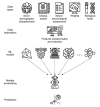Artificial Intelligence for Alzheimer's Disease: Promise or Challenge?
- PMID: 34441407
- PMCID: PMC8391160
- DOI: 10.3390/diagnostics11081473
Artificial Intelligence for Alzheimer's Disease: Promise or Challenge?
Abstract
Decades of experimental and clinical research have contributed to unraveling many mechanisms in the pathogenesis of Alzheimer's disease (AD), but the puzzle is still incomplete. Although we can suppose that there is no complete set of puzzle pieces, the recent growth of open data-sharing initiatives collecting lifestyle, clinical, and biological data from AD patients has provided a potentially unlimited amount of information about the disease, far exceeding the human ability to make sense of it. Moreover, integrating Big Data from multi-omics studies provides the potential to explore the pathophysiological mechanisms of the entire biological continuum of AD. In this context, Artificial Intelligence (AI) offers a wide variety of methods to analyze large and complex data in order to improve knowledge in the AD field. In this review, we focus on recent findings and future challenges for AI in AD research. In particular, we discuss the use of Computer-Aided Diagnosis tools for AD diagnosis and the use of AI to potentially support clinical practices for the prediction of individual risk of AD conversion as well as patient stratification in order to finally develop effective and personalized therapies.
Keywords: Alzheimer’s disease; artificial intelligence; diagnosis; machine learning.
Conflict of interest statement
The authors declare no conflict of interest.
Figures





References
-
- McKeith I.G., Boeve B.F., Dickson D.W., Halliday G., Taylor J.-P., Weintraub D., Aarsland D., Galvin J., Attems J., Ballard C.G., et al. Diagnosis and Management of Dementia with Lewy Bodies: Fourth Consensus Report of the DLB Consortium. Neurology. 2017;89:88–100. doi: 10.1212/WNL.0000000000004058. - DOI - PMC - PubMed
-
- Rascovsky K., Hodges J.R., Knopman D., Mendez M.F., Kramer J.H., Neuhaus J., van Swieten J.C., Seelaar H., Dopper E.G.P., Onyike C.U., et al. Sensitivity of Revised Diagnostic Criteria for the Behavioural Variant of Frontotemporal Dementia. Brain. 2011;134:2456–2477. doi: 10.1093/brain/awr179. - DOI - PMC - PubMed
Publication types
LinkOut - more resources
Full Text Sources

